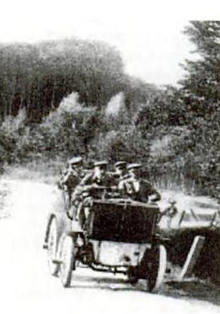Austrian Automobile Club
The Austrian Automobile Club ( ÖAC ) was founded on February 6, 1898 as the first advocacy group for the early motorists and pursued the goal of spreading and asserting the automobile in Austria. In addition, the club organized automobile exhibitions in Vienna and car races in order to make automobiles popular. From 1900 the club members published the periodical "Allgemeine Automobil-Zeitung". In the middle of the 20th century, the ÖAC merged with the "Austrian Touring Club" in the ÖAMTC .
history
Purchasing automobiles was extremely expensive at the beginning of the 20th century, which is why membership was initially only open to the nobility and the upper classes. The first president of the club was Gustav Graf Pötting . The 206 founding members included Philipp Haas , Ludwig Lohner , Dominik Hardegg , Sir Paul Eduard von Schoeller , Alexander Pallavicini , Archduke Franz Salvator , Hans Wilczek and, finally, Siegfried Wimpffen , who had already bought a steam car in the fall of 1892 and thus is considered Austria's first automobile manufacturer. Wimpffen asked the "Department for Spectacle" in the Vienna police for a permit to operate the same.
In the year it was founded, the club acquired the second Marcus car, built from 1888–89 by the Märky, Bromovsky & Schulz company , Adamsthal in Moravia , based on drawings by Siegfried Marcus , and subsequently in 1915 as a permanent loan to the Technical Museum in Vienna Was made available.
The club was committed to the organization of the first car exhibitions, starting with the "Collective Exhibition of Austrian Automobile Manufacturers" held in 1898 as part of the Vienna anniversary exhibition . Jacob Lohner showed a gasoline automobile and a “conventional” electric vehicle and Ignaz Schustal from the Nesselsdorfer Wagenbau-Fabrik presented the “President” model. This vehicle got its name based on the ÖAC President Gustav Graf Pötting and is the first industrially manufactured Austrian automobile in the Austro-Hungarian Empire. The “President” became the property of the club as a gift. The second Marcus car was also on display there.
With a decree of July 15, 1898, the ÖAC achieved that its members were allowed to enter and leave their homes in the first district of Vienna. To do this, however, a horse had to be harnessed to the carriage.
With the “President” model, the ÖAC organized the first training courses for chauffeurs in 1899 and today this facility is often referred to as the first driving school for automobiles in a historical context. In order to guarantee the fuel supply across the board, the automobile club sat down with executing companies who set up gasoline stations all over Austria. In 1900 there were 70 and in 1908 there were already 600 such stations. In this context it is noteworthy that in the beginning of the automobile age animal welfare organizations appeared as additional sponsors of the automobile in order to alleviate the suffering of the horses.
In 1899 the organization of the “I. International Motor Show "and 1901 the" II. International Motor Show ”, both in Vienna. In 1903 the club succeeded with the “ III. International Automobile Exhibition ”in the flower rooms of the Austrian Horticultural Society, the first major show in Vienna with a large number of international exhibitors.
In 1899, the ÖAC organized a club outing on Semmering for the first time . The Semmering races were held annually from 1900 onwards, but they were discontinued after 10 years due to massive complaints from the population. In 1899 the first Exelberg race was initiated by the ÖAC, for which the ÖAMTC organized a revival in June 2006 with the award of the Exelberg Prize. These first held car races soon developed into social events.
In 1914, the association's work was interrupted, the motorists went to the front of the First World War in the " kk Freiwilligen-Motorkorps " . In 1929 the ÖAC set up 3,500 traffic signs (warning boards) on Austrian federal roads.
The foundation of the ÖAMTC
In 1935, the ÖAC and the “Austrian Touring Club” (ÖTC) founded in 1896 formed a working group and signed joint resolutions called “ÖATC”. In National Socialist Germany both clubs were then dissolved and their assets confiscated. The ÖAC and the ÖTC merged on December 17, 1946 to form the ÖAMTC with its first president Manfred Mautner Markhof .
literature
- Editions digitized by the Austrian National Library : Allgemeine Automobil-Zeitung (online at ANNO ).
- The Viennese clubs of today. In: Neues Wiener Journal , March 30, 1929, p. 6 (online at ANNO ).
Web links
- ÖAMTC website with a review
- Website of the Haltau driving school with a short historical excursion
- The reactions of the population to early automobilism in Austria, diploma thesis by Jutta Czabaun, Vienna 2008 (PDF, 3.6 MiB)
- Austria Motor Verans website
Individual evidence
- ^ Letters from Märky, Bromovsky & Schulz dated January 17, 1901 and February 1, 1901 to Prof. Czischek-Christen, Vienna
- ^ OTS press release of September 12, 2006
- ↑ Page no longer available , search in web archives: Pressetext.de of August 20, 2007
- ↑ a b page no longer available , search in web archives: ÖAMTC Oldtimerführer (PDF, accessed on March 30, 2009)



